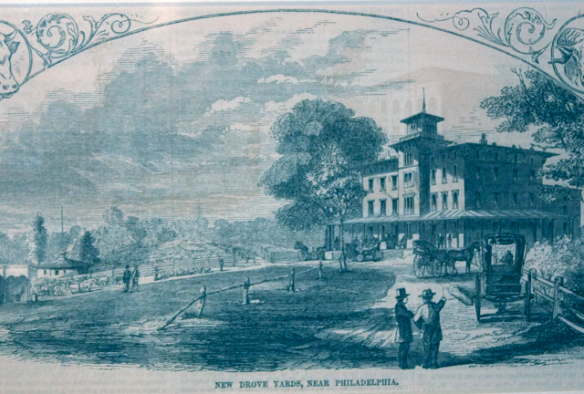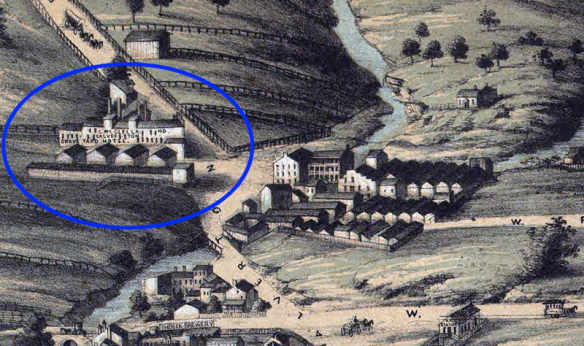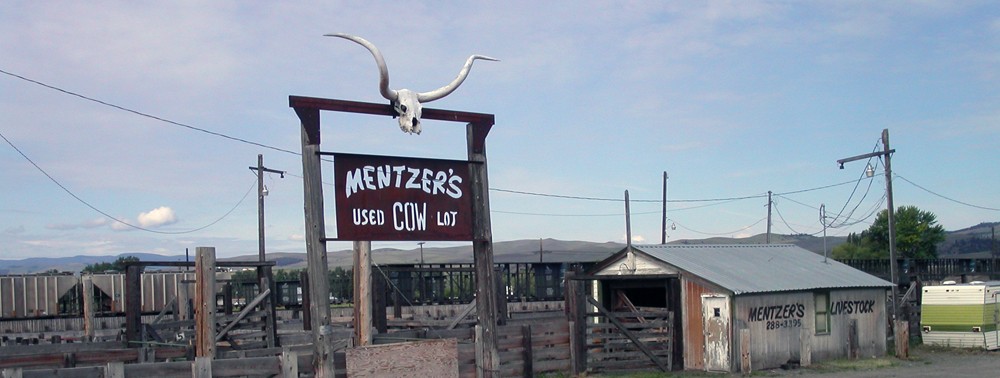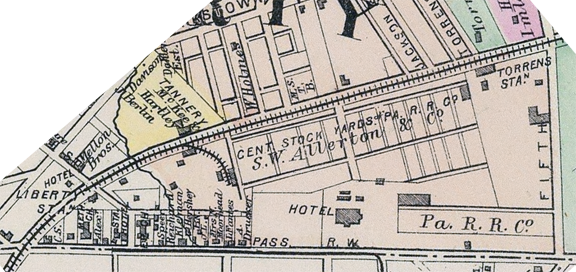My paper on the development of stockyards in the eastern United States (and ultimately, Chicago) was presented at the 2009 Vernacular Architecture Forum conference in Butte, Montana. Last week I learned that a revised and expanded version will be published later this year. Details to come. The paper was published in Western Pennsylvania History: Model for the Nation: Sale, Slaughter and Processing at the East Liberty Stockyards (2010).
In the meantime, here’s an illustrated version of the 2009 VAF paper abstract:
Cowboys in the City: Eastern Stockyards and the Urban Fabric
Nineteenth century cities needed animals for food and work. Between the rural farms and ranges where livestock was raised and the urban markets where hogs, cattle, and sheep were sold and slaughtered there were places where drovers, farmers, shippers, dealers, and butchers stopped to rest and transact business. These places sprang up along rural turnpikes and near railroad depots and terminals. For much of their history these sites were little more than inns with enclosed pens and outbuildings to service the passing droves. In the 1850s animals increasingly moved from the roads to the rails as the railroads closed the gaps between eastern cities and the expanding western frontier.

"New Drove Yards Near Philadelphia." Ballou's Dollar Monthly Magazine, September 1862. From the author's collection.

Calverton Drove Yards, Baltimore, Maryland, c. 1869. E. Sachse & Co.'s Bird's Eye View of the City of Baltimore.
The meat-producing and livestock industries share a common origin narrative in which the world’s first union stockyards opened in Chicago in 1865. The opening of the Chicago Union Stock Yards is widely hailed as a turning point in American history because for the first time a city’s dispersed drove yards were concentrated into a single integrated shipping and sales facility. For much of the twentieth century the Chicago stockyards were considered the prototype for all of the union stockyards that opened after them.
Less well-known, however were the union stockyards opened in February 1864 by the Pennsylvania Railroad in a farm field six miles east of Pittsburgh. The East Liberty stockyards were built to reduce the costs involved in switching eastbound animals arriving in Pittsburgh via the Pittsburgh, Fort Wayne, and Chicago Railroad bound for Philadelphia, Baltimore, and New York on the Pennsylvania Railroad. Owned by the railroad, the East Liberty stockyards were managed by a firm comprised of partners who had spent decades in livestock shipping and in the drove yard business in New York City and Chicago. The business done at East Liberty provided the basis for founding the Chicago Union Stock Yards. After East Liberty and Chicago, the partners and their associates opened additional stockyards for the Pennsylvania Railroad and its leading competitors, the New York Central and the Erie Railroads, in Philadelphia, Albany, Buffalo, Suspension Bridge (New York), Jersey City, Weehawken (New Jersey), and East St. Louis.

West Philadelphia Stockyards, c. 1902, visible in the lower right of the image. Library of Congress image.

West Philadelphia Stockyards, Grays Ferry Ave. Built in 1931 to replace the 1876 yards constructed where Amtrak's 30th Street Station now stands, the concrete building was demolished c. 2005. Photo by the author, 1998.
This paper casts new light on the East Liberty stockyards and their significance. In the creation and early operation of the East Liberty stockyards we can see the integration strategies deployed by the Pennsylvania Railroad in consolidating livestock operations in urban areas. These efforts influenced the development of cultural landscapes in cities throughout the United States where dispersed drove yards morphed into consolidated union stockyards. The newly reconfigured industry’s first movers were among the most influential and powerful livestock entrepreneurs in American history. Like the livestock industry’s physical assets, the human assets involved in the organization of the East Liberty stockyards and its sister facilities have been eclipsed by better known personalities like Philip Armour, Gustavus Swift, and Nelson Morris.
© 2010 David S. Rotenstein
Shortlink for this post: https://wp.me/p1bnGQ-aB





Hello,
I came accross this page while trying to find information about the East Liberty stockyards for my mother. Her dad worked there, and she tells me that she grew up frequently hearing them mentioned; but she doesn’t know anything about them or when/why they closed. I think I vaguely remember hearing something about a fire, buI’m not really sure.
Would you possibly be able to shed any light on when the East Liberty stockyards closed down, and why?
Thank you for your time, and have a nice day!
Kind regards,
Cheryl Campbell
Cheryl, the East Liberty stockyards closed in 1903. The stockyards relocated to Herr’s Island.
I am writing a story for the Auctioneer’s Guide of the Lancaster Farming newspaper. My story is about the Mercer Livestock Auction that was started by John Kingersky in 1960 to provide a local market for farmers in northwestern Pennsylvania. Up to that time they took their animals to Pittsburgh.
I would like to know when the Pittsburgh livestock markets closed and were they in several places. I have seen Herr’s Island that is on the Allegheny River and I have heard that they were on Neville Island that is on the Ohio River.
Any information or links that you could share would be very much appreciated.
Carol Ann Gregg
Western Pa. Correspondent
Lancaster Farming
It would appear a spur coming off the PARR main line to the site of the stockyards still exists. It was also used for the Nabisco bakery on the site, a person who worked on the cars coming in, informed me. I find this to be fascinating and ask how to look into that? If it is a remnant of the stockyards, is this of historic interest? Thank you, Mike
P.S. Eye-opening, wonderful article
Mr. Rotenstein,
What are your thoughts on why livestock continued to be driven from Allegheny to downtown Pittsburgh until the East Liberty Stockyards opened, even though the Allegheny River bridge opened in 1857 providing a direct connection between the Pgh,, Ft. Wayne & Chicago and the Pennsylvania Railroad?